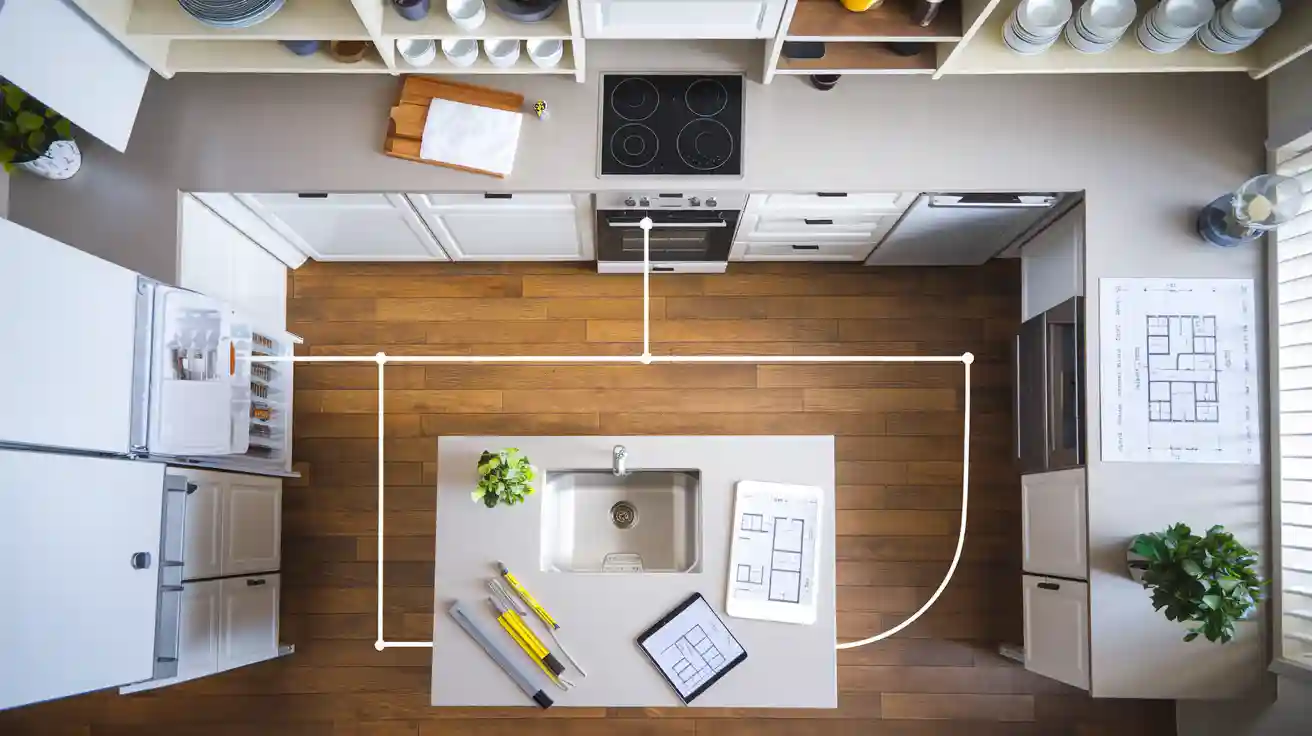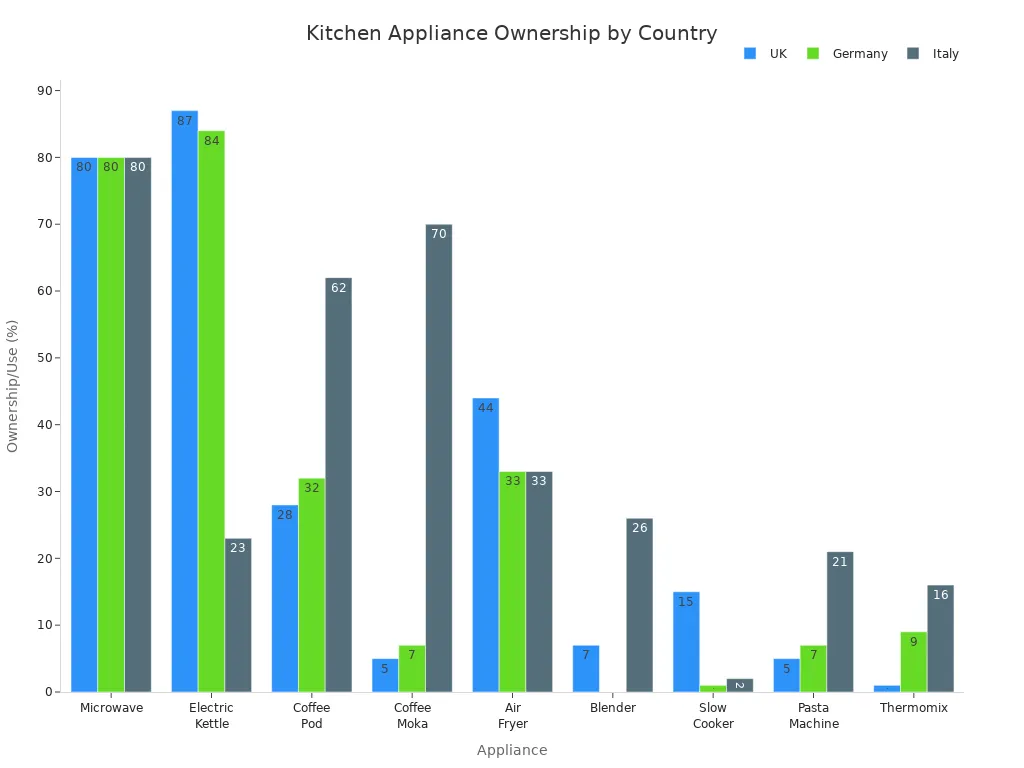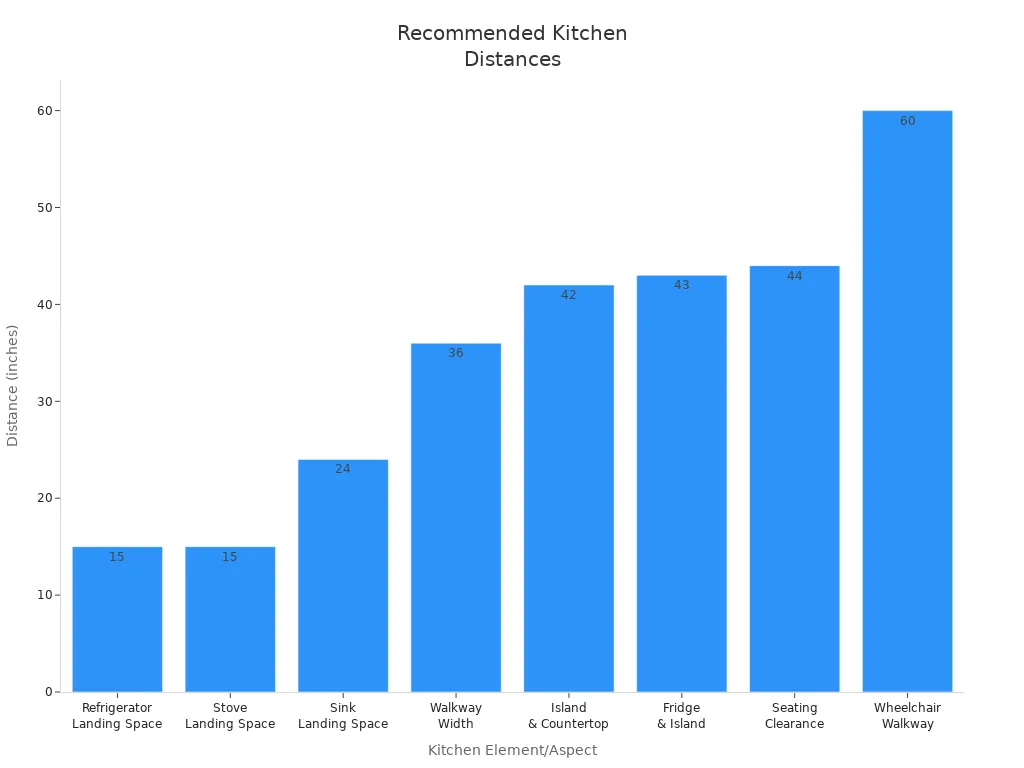
You want a kitchen with appliance solutions that support both function and modern design. When you choose built-in appliances, you create a seamless look that matches modern design aesthetics. Smart appliances, built-in storage, and integrated features help you achieve a functional kitchen design with improved aesthetics and a truly modern, functional space.
Assessing Your Kitchen with Appliance Needs
Identifying Essential Appliances for a Functional Kitchen
You start creating a functional kitchen by listing the appliances you use every day. Think about what you need for cooking, cleaning, and food storage. Most modern kitchens include a refrigerator, oven, cooktop, and dishwasher. Many homes also use microwaves, coffee machines, and air fryers. These appliances help you save time and improve kitchen functionality.
Here is a table showing the most commonly used appliances in modern kitchens across different countries:
| Appliance | UK Ownership/Use | Germany Ownership/Use | Italy Ownership/Use | Notes on Usage and Popularity |
|---|---|---|---|---|
| Microwave | ~80% | ~80% | ~80% | Most popular overall, top appliance consumers can’t live without |
| Electric Kettle | 87% | 84% | 23% | Highly relied upon in UK and Germany, less in Italy |
| Coffee Machines | 28% (pod), 5% (moka) | 32% (pod), 7% (moka) | 62% (pod), 70% (moka) | Coffee dominates in Italy, less so in UK and Germany |
| Air Fryers | 44% | 33% | 33% | Rapid growth, especially in UK |
| Toaster | Top 3 in UK and Germany | Top 3 in Germany | N/A | Common in UK and Germany |

When you select built-in appliances, you create a kitchen with appliance solutions that blend with your design. Built-in ovens, microwaves, and refrigerators help you achieve a seamless look and improve kitchen functionality.
Measuring Your Kitchen and Mapping Functional Zones
You need to measure your kitchen before you plan your kitchen layout. Accurate measurements help you fit built-in appliances and create an efficient space. Use a tape measure to check the width, depth, and height of each area. Write down the size of your cabinets, counters, and walkways.
Professional kitchen planners recommend these standard measurements:
| Kitchen Zone Aspect | Recommended Standard Measurement |
|---|---|
| Free prep space | 36 inches |
| Space beside stove | Minimum 12 inches |
| Space beside sink | Minimum 18 inches |
| Work aisle width (single cook) | Minimum 42 inches |
| Work aisle width (two cooks) | Minimum 48 inches |
| Walkway width (non-prep areas) | Minimum 36 inches |
| Standard countertop height | 36 inches |
| Raised bar counter height | 42 inches |
| Cabinet depth | 24 inches |
| Countertop depth | Typically 25 inches (includes small lip) |
Tip: Mapping functional zones in your kitchen groups tasks like food prep, cooking, and cleaning. This method reduces congestion and improves efficiency. Place built-in appliances in zones where you use them most. For example, keep your built-in oven near your prep area and your built-in dishwasher close to the sink. This approach helps you create an efficient space and supports kitchen functionality.
When you plan your kitchen with appliance integration, you improve workflow and make daily tasks easier. Creating a functional kitchen starts with careful measurement and smart mapping of zones.
Functional Kitchen Design and Appliance Integration
The Work Triangle and Optimizing Workflow
You can create a functional kitchen by focusing on the work triangle. The work triangle connects the sink, stove, and refrigerator. This layout helps you move easily between the main tasks: cleaning, cooking, and storing food. When you plan your kitchen layout, you improve efficiency and reduce wasted steps.
The recommended distances between these key appliances support efficient workflow and comfort. You should keep enough landing space near each appliance for safety and convenience. Here is a table showing the best distances for a functional kitchen:
| Kitchen Element/Aspect | Recommended Distance/Space |
|---|---|
| Refrigerator Landing Space | 15 inches on one or both sides, or 15 inches above under-counter fridge; if not possible, 15 inches landing no more than 48 inches in front |
| Stove (Cook Zone) Landing Space | Minimum 12 inches on one side, 15 inches on the other side; 9 inches behind if on peninsula/island at same height |
| Sink (Clean-Up Zone) Landing Space | At least 24 inches on one side, 18 inches on the other side |
| Walkway Minimum Width | 36 inches |
| Distance Between Kitchen Island & Countertop | 42 to 48 inches |
| Clearance Between Fridge & Island | Minimum 32 inches if no walkway, recommended 43 inches |
| Seating Clearance at Breakfast Bar/Table | Minimum 32 inches (no walkway), 44 inches preferred for foot traffic |
| Wheelchair Access Walkway Width | At least 60 inches |
| Combined Landing Areas | When two items needing landing space are close, use larger landing size plus 12 inches |

Tip: You can boost kitchen functionality by keeping the work triangle clear of obstacles. Place built-in appliances where you use them most. This method helps you achieve seamless integration and efficient workflow.
Choosing the Right Kitchen Layout for Appliances
You have many options for kitchen layout. Each layout supports different needs and space sizes. You can choose from galley, L-shaped, U-shaped, or island layouts. When you select a layout, you should think about how you use your kitchen and where you want your appliances.
- Galley Layout: You place appliances along two parallel walls. This design works well for small kitchens and supports space efficiency.
- L-Shaped Layout: You arrange appliances along two adjoining walls. This layout gives you more room for built-in appliances and supports open movement.
- U-Shaped Layout: You use three walls for appliances and storage. This design creates a functional kitchen with plenty of space for built-in appliances and prep zones.
- Island Layout: You add a central island for extra storage, seating, or appliances. You can install built-in cooktops or sinks in the island for a modern look.
When you plan your kitchen with appliance integration, you should place built-in appliances in zones that match your workflow. You can group your refrigerator, oven, and dishwasher near prep and clean-up areas. This approach improves kitchen functionality and supports a seamless kitchen with appliance solutions.
Note: You can increase space efficiency by choosing built-in appliances that fit your kitchen layout. Built-in ovens, microwaves, and refrigerators save space and create a modern, unified design.
Built-in vs. Freestanding Appliances in a Functional Kitchen
You can choose between built-in and freestanding appliances for your kitchen. Built-in appliances fit into cabinets and counters. Freestanding appliances stand alone and can move easily. Each type has benefits for design, functionality, and efficiency.
Built-in Appliances:
- You achieve seamless integration and a modern look.
- You save space and improve kitchen functionality.
- You can customize placement for efficient workflow.
- You boost aesthetics by hiding appliances behind cabinet panels.
- You support energy efficiency with advanced features.
Freestanding Appliances:
- You can move appliances if you change your kitchen layout.
- You may find installation easier and less expensive.
- You can replace appliances without changing cabinets.
Recent studies show that integrated appliances help you save energy and lower utility costs. Induction cooktops use electromagnetic energy to heat cookware directly. This method reduces heat loss and improves safety. Energy Star-certified refrigerators use smart sensors and high-efficiency compressors to cut electricity use. Smart ovens use AI for precise temperature control and automated cooking, which reduces energy waste.
- Induction cooking heats cookware directly, saving energy and improving indoor air quality.
- Energy Star refrigerators use better insulation and smart sensors to lower electricity use.
- Smart ovens use AI for precise cooking and remote monitoring, reducing energy waste.
The SMACK system uses heat pump technology to reuse energy across kitchen appliances. Studies show this integrated approach can save up to 50% of energy in a kitchen with appliance solutions. You support sustainable design and lower costs by choosing built-in appliances with energy-saving features.
Callout: You can create a functional kitchen by choosing built-in appliances that match your design and workflow. Built-in appliances help you achieve seamless integration, space efficiency, and a modern look.
You create a functional kitchen by planning for seamless appliance integration. Start by assessing your needs and mapping zones. Choose integrated appliances and handleless cabinetry for a smooth look. Use consistent materials and conceal small appliances. Professional installation ensures your kitchen feels unified, efficient, and ready for daily living.
FAQ
What is the best way to hide small appliances in my kitchen?
You can use appliance garages, pull-out shelves, or deep drawers. These options keep your counters clear and help your kitchen look neat.
Tip: Choose handleless cabinetry for a seamless look.
How do I make sure my kitchen layout fits all my appliances?
Measure each appliance before you plan your layout. Check the width, depth, and height. Leave enough space for doors to open and for safe movement.
Can I mix built-in and freestanding appliances in one kitchen?
Yes, you can mix both types. Place built-in appliances where you want a seamless look. Use freestanding appliances for flexibility and easy replacement.


